+ Open data
Open data
- Basic information
Basic information
| Entry | Database: PDB / ID: 6ulg | |||||||||||||||||||||||||||
|---|---|---|---|---|---|---|---|---|---|---|---|---|---|---|---|---|---|---|---|---|---|---|---|---|---|---|---|---|
| Title | Cryo-EM structure of the FLCN-FNIP2-Rag-Ragulator complex | |||||||||||||||||||||||||||
 Components Components |
| |||||||||||||||||||||||||||
 Keywords Keywords | SIGNALING PROTEIN / FLCN-FNIP2 / Rag GTPases / Ragulator | |||||||||||||||||||||||||||
| Function / homology |  Function and homology information Function and homology informationnegative regulation of cell proliferation involved in kidney development / cell proliferation involved in kidney development / negative regulation of post-translational protein modification / regulation of cholesterol import / positive regulation of protein localization to lysosome / regulation of cell-substrate junction organization / regulation of cholesterol efflux / Gtr1-Gtr2 GTPase complex / FNIP-folliculin RagC/D GAP / negative regulation of brown fat cell differentiation ...negative regulation of cell proliferation involved in kidney development / cell proliferation involved in kidney development / negative regulation of post-translational protein modification / regulation of cholesterol import / positive regulation of protein localization to lysosome / regulation of cell-substrate junction organization / regulation of cholesterol efflux / Gtr1-Gtr2 GTPase complex / FNIP-folliculin RagC/D GAP / negative regulation of brown fat cell differentiation / regulation of Ras protein signal transduction / Ragulator complex / protein localization to cell junction / regulation of TORC1 signaling / regulation of pro-B cell differentiation / negative regulation of lysosome organization / protein localization to lysosome / regulation of TOR signaling / MTOR signalling / fibroblast migration / lysosome localization / Energy dependent regulation of mTOR by LKB1-AMPK / endosome organization / ATPase inhibitor activity / Amino acids regulate mTORC1 / TORC1 signaling / cell-cell junction assembly / negative regulation of glycolytic process / negative regulation of TOR signaling / kinase activator activity / protein localization to membrane / negative regulation of cold-induced thermogenesis / endosomal transport / lysosome organization / azurophil granule membrane / small GTPase-mediated signal transduction / Macroautophagy / negative regulation of Rho protein signal transduction / regulation of cell size / positive regulation of transforming growth factor beta receptor signaling pathway / RHOJ GTPase cycle / RHOQ GTPase cycle / TOR signaling / mTORC1-mediated signalling / hemopoiesis / CDC42 GTPase cycle / tertiary granule membrane / RHOH GTPase cycle / ficolin-1-rich granule membrane / RHOG GTPase cycle / regulation of receptor recycling / RAC2 GTPase cycle / RAC3 GTPase cycle / positive regulation of TOR signaling / enzyme inhibitor activity / enzyme-substrate adaptor activity / response to amino acid / cellular response to nutrient levels / specific granule membrane / positive regulation of intrinsic apoptotic signaling pathway / energy homeostasis / protein-membrane adaptor activity / ERK1 and ERK2 cascade / RAC1 GTPase cycle / positive regulation of TORC1 signaling / positive regulation of autophagy / negative regulation of phosphatidylinositol 3-kinase/protein kinase B signal transduction / intrinsic apoptotic signaling pathway / transforming growth factor beta receptor signaling pathway / negative regulation of autophagy / RNA splicing / GTPase activator activity / viral genome replication / cellular response to amino acid starvation / cholesterol homeostasis / guanyl-nucleotide exchange factor activity / cellular response to starvation / epithelial cell proliferation / Regulation of PTEN gene transcription / tumor necrosis factor-mediated signaling pathway / positive regulation of interleukin-8 production / TP53 Regulates Metabolic Genes / cellular response to amino acid stimulus / regulation of cell growth / phosphoprotein binding / phosphatidylinositol 3-kinase/protein kinase B signal transduction / positive regulation of protein-containing complex assembly / MAP2K and MAPK activation / negative regulation of ERK1 and ERK2 cascade / positive regulation of protein localization to nucleus / response to virus / centriolar satellite / intrinsic apoptotic signaling pathway in response to DNA damage / negative regulation of epithelial cell proliferation / mitotic spindle / GDP binding / late endosome membrane / intracellular protein localization / late endosome / glucose homeostasis Similarity search - Function | |||||||||||||||||||||||||||
| Biological species |  Homo sapiens (human) Homo sapiens (human) | |||||||||||||||||||||||||||
| Method | ELECTRON MICROSCOPY / single particle reconstruction / cryo EM / Resolution: 3.31 Å | |||||||||||||||||||||||||||
 Authors Authors | Shen, K. / Rogala, K.B. / Yu, Z.H. / Sabatini, D.M. | |||||||||||||||||||||||||||
| Funding support |  United States, 7items United States, 7items
| |||||||||||||||||||||||||||
 Citation Citation |  Journal: Cell / Year: 2019 Journal: Cell / Year: 2019Title: Cryo-EM Structure of the Human FLCN-FNIP2-Rag-Ragulator Complex. Authors: Kuang Shen / Kacper B Rogala / Hui-Ting Chou / Rick K Huang / Zhiheng Yu / David M Sabatini /  Abstract: mTORC1 controls anabolic and catabolic processes in response to nutrients through the Rag GTPase heterodimer, which is regulated by multiple upstream protein complexes. One such regulator, FLCN- ...mTORC1 controls anabolic and catabolic processes in response to nutrients through the Rag GTPase heterodimer, which is regulated by multiple upstream protein complexes. One such regulator, FLCN-FNIP2, is a GTPase activating protein (GAP) for RagC/D, but despite its important role, how it activates the Rag GTPase heterodimer remains unknown. We used cryo-EM to determine the structure of FLCN-FNIP2 in a complex with the Rag GTPases and Ragulator. FLCN-FNIP2 adopts an extended conformation with two pairs of heterodimerized domains. The Longin domains heterodimerize and contact both nucleotide binding domains of the Rag heterodimer, while the DENN domains interact at the distal end of the structure. Biochemical analyses reveal a conserved arginine on FLCN as the catalytic arginine finger and lead us to interpret our structure as an on-pathway intermediate. These data reveal features of a GAP-GTPase interaction and the structure of a critical component of the nutrient-sensing mTORC1 pathway. | |||||||||||||||||||||||||||
| History |
|
- Structure visualization
Structure visualization
| Movie |
 Movie viewer Movie viewer |
|---|---|
| Structure viewer | Molecule:  Molmil Molmil Jmol/JSmol Jmol/JSmol |
- Downloads & links
Downloads & links
- Download
Download
| PDBx/mmCIF format |  6ulg.cif.gz 6ulg.cif.gz | 396.8 KB | Display |  PDBx/mmCIF format PDBx/mmCIF format |
|---|---|---|---|---|
| PDB format |  pdb6ulg.ent.gz pdb6ulg.ent.gz | 303.7 KB | Display |  PDB format PDB format |
| PDBx/mmJSON format |  6ulg.json.gz 6ulg.json.gz | Tree view |  PDBx/mmJSON format PDBx/mmJSON format | |
| Others |  Other downloads Other downloads |
-Validation report
| Arichive directory |  https://data.pdbj.org/pub/pdb/validation_reports/ul/6ulg https://data.pdbj.org/pub/pdb/validation_reports/ul/6ulg ftp://data.pdbj.org/pub/pdb/validation_reports/ul/6ulg ftp://data.pdbj.org/pub/pdb/validation_reports/ul/6ulg | HTTPS FTP |
|---|
-Related structure data
| Related structure data |  20814MC M: map data used to model this data C: citing same article ( |
|---|---|
| Similar structure data |
- Links
Links
- Assembly
Assembly
| Deposited unit | 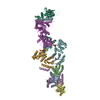
|
|---|---|
| 1 |
|
- Components
Components
-Protein , 2 types, 2 molecules LN
| #1: Protein | Mass: 64551.191 Da / Num. of mol.: 1 Source method: isolated from a genetically manipulated source Source: (gene. exp.)  Homo sapiens (human) / Gene: FLCN, BHD / Production host: Homo sapiens (human) / Gene: FLCN, BHD / Production host:  Homo sapiens (human) / References: UniProt: Q8NFG4 Homo sapiens (human) / References: UniProt: Q8NFG4 |
|---|---|
| #9: Protein | Mass: 122260.195 Da / Num. of mol.: 1 Source method: isolated from a genetically manipulated source Source: (gene. exp.)  Homo sapiens (human) / Gene: FNIP2, FNIPL, KIAA1450, MAPO1 / Production host: Homo sapiens (human) / Gene: FNIP2, FNIPL, KIAA1450, MAPO1 / Production host:  Homo sapiens (human) / References: UniProt: Q9P278 Homo sapiens (human) / References: UniProt: Q9P278 |
-Ragulator complex protein ... , 5 types, 5 molecules ABCDE
| #2: Protein | Mass: 13637.678 Da / Num. of mol.: 1 Source method: isolated from a genetically manipulated source Source: (gene. exp.)  Homo sapiens (human) / Gene: LAMTOR3, MAP2K1IP1, MAPKSP1, PRO2783 / Production host: Homo sapiens (human) / Gene: LAMTOR3, MAP2K1IP1, MAPKSP1, PRO2783 / Production host:  |
|---|---|
| #3: Protein | Mass: 13517.450 Da / Num. of mol.: 1 Source method: isolated from a genetically manipulated source Source: (gene. exp.)  Homo sapiens (human) / Gene: LAMTOR2, MAPBPIP, ROBLD3, HSPC003 / Production host: Homo sapiens (human) / Gene: LAMTOR2, MAPBPIP, ROBLD3, HSPC003 / Production host:  |
| #4: Protein | Mass: 9622.900 Da / Num. of mol.: 1 Source method: isolated from a genetically manipulated source Source: (gene. exp.)  Homo sapiens (human) / Gene: LAMTOR5, HBXIP, XIP / Production host: Homo sapiens (human) / Gene: LAMTOR5, HBXIP, XIP / Production host:  |
| #5: Protein | Mass: 10753.236 Da / Num. of mol.: 1 Source method: isolated from a genetically manipulated source Source: (gene. exp.)  Homo sapiens (human) / Gene: LAMTOR4, C7orf59 / Production host: Homo sapiens (human) / Gene: LAMTOR4, C7orf59 / Production host:  |
| #6: Protein | Mass: 17762.775 Da / Num. of mol.: 1 Source method: isolated from a genetically manipulated source Source: (gene. exp.)  Homo sapiens (human) / Gene: LAMTOR1, C11orf59, PDRO, PP7157 / Production host: Homo sapiens (human) / Gene: LAMTOR1, C11orf59, PDRO, PP7157 / Production host:  |
-Ras-related GTP-binding protein ... , 2 types, 2 molecules FG
| #7: Protein | Mass: 36628.168 Da / Num. of mol.: 1 / Mutation: T21N Source method: isolated from a genetically manipulated source Details: RagA containing a T21N mutation / Source: (gene. exp.)  Homo sapiens (human) / Gene: RRAGA / Production host: Homo sapiens (human) / Gene: RRAGA / Production host:  |
|---|---|
| #8: Protein | Mass: 44271.832 Da / Num. of mol.: 1 Source method: isolated from a genetically manipulated source Source: (gene. exp.)  Homo sapiens (human) / Gene: RRAGC / Production host: Homo sapiens (human) / Gene: RRAGC / Production host:  |
-Non-polymers , 3 types, 3 molecules 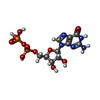




| #10: Chemical | ChemComp-GDP / |
|---|---|
| #11: Chemical | ChemComp-GNP / |
| #12: Chemical | ChemComp-MG / |
-Details
| Has ligand of interest | N |
|---|---|
| Has protein modification | Y |
-Experimental details
-Experiment
| Experiment | Method: ELECTRON MICROSCOPY |
|---|---|
| EM experiment | Aggregation state: PARTICLE / 3D reconstruction method: single particle reconstruction |
- Sample preparation
Sample preparation
| Component | Name: Nonameric complex of FLCN-FNIP2 with its substrate Rag GTPases and the scaffolding protein complex Ragulator Type: COMPLEX / Entity ID: #1-#9 / Source: RECOMBINANT |
|---|---|
| Molecular weight | Value: 0.38 MDa / Experimental value: NO |
| Source (natural) | Organism:  Homo sapiens (human) Homo sapiens (human) |
| Source (recombinant) | Organism:  |
| Buffer solution | pH: 7.4 |
| Specimen | Conc.: 8 mg/ml / Embedding applied: NO / Shadowing applied: NO / Staining applied: NO / Vitrification applied: YES |
| Vitrification | Cryogen name: ETHANE |
- Electron microscopy imaging
Electron microscopy imaging
| Experimental equipment |  Model: Titan Krios / Image courtesy: FEI Company |
|---|---|
| Microscopy | Model: FEI TITAN KRIOS |
| Electron gun | Electron source:  FIELD EMISSION GUN / Accelerating voltage: 300 kV / Illumination mode: FLOOD BEAM FIELD EMISSION GUN / Accelerating voltage: 300 kV / Illumination mode: FLOOD BEAM |
| Electron lens | Mode: BRIGHT FIELD |
| Image recording | Electron dose: 59.2 e/Å2 / Film or detector model: GATAN K2 BASE (4k x 4k) |
- Processing
Processing
| Software | Name: PHENIX / Version: 1.16_3549: / Classification: refinement | ||||||||||||||||||||||||
|---|---|---|---|---|---|---|---|---|---|---|---|---|---|---|---|---|---|---|---|---|---|---|---|---|---|
| EM software | Name: PHENIX / Category: model refinement | ||||||||||||||||||||||||
| CTF correction | Type: PHASE FLIPPING AND AMPLITUDE CORRECTION | ||||||||||||||||||||||||
| Symmetry | Point symmetry: C1 (asymmetric) | ||||||||||||||||||||||||
| 3D reconstruction | Resolution: 3.31 Å / Resolution method: FSC 0.143 CUT-OFF / Num. of particles: 126984 / Symmetry type: POINT | ||||||||||||||||||||||||
| Refine LS restraints |
|
 Movie
Movie Controller
Controller



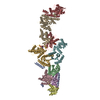
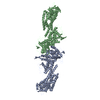
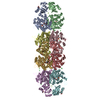
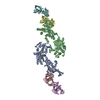
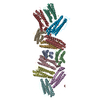
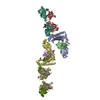
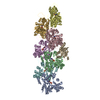
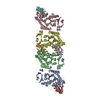


 PDBj
PDBj









